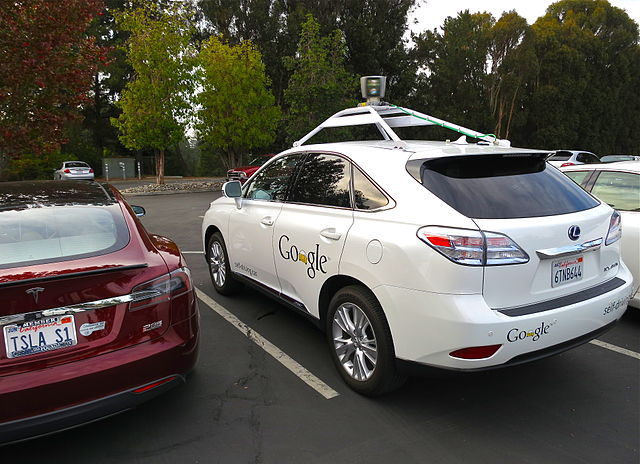Google Car
In 2011 Nevada passed a law that permits operation of autonomous vehicles in the State. The first driverless vehicle license was issued to Google, the internet search giant. The licensed Google car is a Toyota Prius that uses Google’s experimental driverless technology. Google now has at least ten vehicles of this kind.
These cars have navigated some of the steeper, more challenging roads in San Francisco, circled Lake Tahoe and driven over the Golden Gate Bridge. In August of 2012, the Google team announced that the cars have gone over 300,000 miles completely accident free. The only accident involving one of these cars occurred when a human was in control of the vehicle. It appears that Google’s self-driving technology is working out well.
Nevada has also licensed Audi to operate a self-driving car in the state. Unlike Google, Audi actually manufacturers vehicles. Some experts predict that we will see driverless cars available for widespread consumer purchase within a decade.
Although many people are sceptical of the technology, I believe that autonomous cars will be very successful. The technology should result in lower accident rates. There are many poor drivers on the road and most people are becoming increasingly distracted with mobile technology. Autonomous vehicles will also be more convenient and productive. Many people would rather focus on things other than driving. Eventually, most cars on the road will be autonomous.
Google Patents
Google has been busy protecting its intellectual property related to driverless vehicles. Here are patent numbers, titles and abstracts of some of the patents google has obtained:
8,473,144 – Controlling vehicle lateral lane positioning
A computing device is be configured to identify an object in a vicinity of a vehicle on a road. The computing device may be configured to estimate, based on characteristics of the vehicle and respective characteristics of the object, an interval of time during which the vehicle will be laterally adjacent to the object. Based on the characteristics of the vehicle, the computing device may be configured to estimate longitudinal positions of the vehicle on the road during the interval of time. Based on the respective characteristics of the object, the computing device may be configured to determine a lateral distance for the vehicle to maintain between the vehicle and the object during the interval of time at the longitudinal positions of the vehicle, and provide instructions to control the vehicle based on the lateral distance.
8,457,827 – Modifying behavior of autonomous vehicle base on predicted behavior of other vehicles.
A vehicle configured to operate in an autonomous mode could determine a current state of the vehicle and the current state of the environment of the vehicle. The environment of the vehicle includes at least one other vehicle. A predicted behavior of the at least one other vehicle could be determined based on the current state of the vehicle and the current state of the environment of the vehicle. A confidence level could also be determined based on the predicted behavior, the current state of the vehicle, and the current state of the environment of the vehicle. In some embodiments, the confidence level may be related to the likelihood of the at least one other vehicle to perform the predicted behavior. The vehicle in the autonomous mode could be controlled based on the predicted behavior, the confidence level, and the current state of the vehicle and its environment.
8,437,501 – Using image and laser constraints to obtain consistent and improved pose estimates in vehicle pose databases
A system for pose generation consisting of a trajectory system, a pose generation system, an intersection extractor, an object identifier, a constraint generator, and a posegraph solver. The trajectory system identifies a number of trajectories based on input positional data of a bounded area. The pose generation system generates one or more poses based on the trajectories. The intersection extractor identifies one or more possible intersections in the one or more poses. The object identifier identifies an object pair for each possible intersection that represents two positional points at each possible intersection. The constraint generator computes and applies one or more intersection constraints to generate an energy value for each object pair based on their geometric relationship. The posegraph solver then minimizes a total energy value by modifying one or more poses and then generates an improved set of pose trajectories based on the modified one or more poses.
8,321,067 – Transitioning a mixed-mode vehicle to autonomous mode
Disclosed are methods and devices for transitioning a mixed-mode autonomous vehicle from a human driven mode to an autonomously driven mode. Transitioning may include stopping a vehicle on a predefined landing strip and detecting a reference indicator. Based on the reference indicator, the vehicle may be able to know its exact position. Additionally, the vehicle may use the reference indictor to obtain an autonomous vehicle instruction via a URL. After the vehicle knows its precise location and has an autonomous vehicle instruction, it can operate in autonomous mode.
7,469,827 – Vehicle information systems and methods
In some of the embodiments described herein, a vehicle information system may be used to generate route map information, schedule information, estimated time of arrival information, or the like based upon location information received from passenger-carried or cargo-carried wireless devices, such as passengers’ cellular phones. In such circumstances, a remote device (e.g., a display device at a vehicle station, a network-connected personal computer, or a cellular phone of a person who might board a mass transit vehicle) may access the route map information, schedule information, and other information related to one or more mass transit vehicles.


